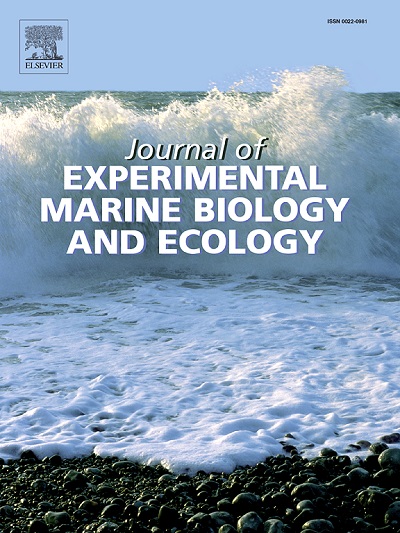Comparison of two calcein administration techniques for marking the shell of the blue mussels (Mytilus spp.) infected with pathogenic microalgae Coccomyxa
IF 1.8
3区 生物学
Q3 ECOLOGY
Journal of Experimental Marine Biology and Ecology
Pub Date : 2025-01-01
DOI:10.1016/j.jembe.2024.152077
引用次数: 0
Abstract
The presence of the L-shaped shell deformity (LSSD) is a reliable biomineral marker for non-lethal detection of wild blue mussels (Mytilus spp.) infected with the unicellular photosynthetic microalgae Coccomyxa sp. However, the LSSD formation rate is unknown. Most literature regarding bivalve shell sclerochronology advocates the fluorochrome calcein as an ideal growth marker. Administration technique of calcein-seawater solution for mussels, injection into mantle cavity or immersion, influences mark quality and staining. The best technique cannot be predicted in advance. Three circumstances may impact the dyeing success for Coccomyxa-infected mussels: mantle colonization with algae, increase in mucus production and biophysiological control in alga-mussel association. This report examines how injection (in field condition) and immersion (for 2 h - field condition; 20 h - laboratory condition) affect shell marking in adult (60–70 mm shell length) Coccomyxa-infected Mytilus spp. Uninfected wild and farmed mussels are used in parallel experiments for comparative purposes. After the staining procedures (calcein concentration 150 mg L ‐1), mussels were caged for 55 days in the Lower St. Lawrence Estuary (Québec, Canada). Results demonstrate that uninfected mussels showed fluorescent marks regardless of the administration techniques, whereas in Coccomyxa-infected mussels marks were visible only after immersion for 20 h. This may suggest that dyeing success could be managed by unknown aspects of biophysiological control in alga-mussel symbiosis. A comparison of images made in 2019 and 2023 indicates no change in calcein marks brightness 4 years after the end of shell staining experiments.
致病性微藻Coccomyxa感染的蓝贻贝(Mytilus spp.)壳标记的两种钙黄素给药技术比较
l形壳畸形(LSSD)的存在是检测感染单细胞光合微藻Coccomyxa sp的野生蓝贻贝(Mytilus spp.)非致死的可靠生物矿物学标志物。然而,LSSD的形成率尚不清楚。大多数关于双壳类贝壳年代学的文献都主张将荧光钙黄蛋白作为理想的生长标志物。贻贝用钙黄素-海水溶液的给药方法是注入或浸泡,影响标记质量和染色。最好的技术是无法提前预测的。三种情况可能影响球菌感染贻贝的染色成功:藻类定殖、粘液产生增加和藻类-贻贝联合中的生物生理控制。本报告探讨了如何注射(在现场条件下)和浸泡(2小时-现场条件下);20小时(实验室条件)对感染coccomyza的贻贝成虫(壳长60-70毫米)的壳标记有影响。未感染的野生贻贝和养殖贻贝在平行实验中进行比较。在完成染色程序(钙黄蛋白浓度为150 mg L‐1)后,将贻贝在Lower St. Lawrence Estuary (qu bec, Canada)笼中饲养55天。结果表明,无论使用何种给药技术,未感染的贻贝都能显示荧光标记,而感染球菌的贻贝只有在浸泡20小时后才能看到荧光标记。这可能表明,染色成功可能是由藻类-贻贝共生中未知的生物生理控制方面控制的。对比2019年和2023年的图像,在贝壳染色实验结束4年后,钙黄蛋白标记亮度没有变化。
本文章由计算机程序翻译,如有差异,请以英文原文为准。
求助全文
约1分钟内获得全文
求助全文
来源期刊
CiteScore
4.30
自引率
0.00%
发文量
98
审稿时长
14 weeks
期刊介绍:
The Journal of Experimental Marine Biology and Ecology provides a forum for experimental ecological research on marine organisms in relation to their environment. Topic areas include studies that focus on biochemistry, physiology, behavior, genetics, and ecological theory. The main emphasis of the Journal lies in hypothesis driven experimental work, both from the laboratory and the field. Natural experiments or descriptive studies that elucidate fundamental ecological processes are welcome. Submissions should have a broad ecological framework beyond the specific study organism or geographic region.
Short communications that highlight emerging issues and exciting discoveries within five printed pages will receive a rapid turnaround. Papers describing important new analytical, computational, experimental and theoretical techniques and methods are encouraged and will be highlighted as Methodological Advances. We welcome proposals for Review Papers synthesizing a specific field within marine ecology. Finally, the journal aims to publish Special Issues at regular intervals synthesizing a particular field of marine science. All printed papers undergo a peer review process before being accepted and will receive a first decision within three months.

 求助内容:
求助内容: 应助结果提醒方式:
应助结果提醒方式:


